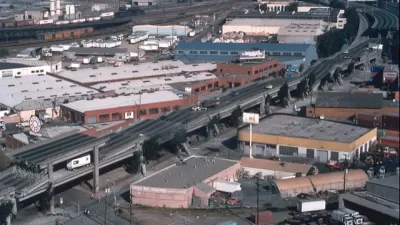Setting aside the debate about fracking's responsibility for swarms of earthquakes in states like Kansas, Texas, and Oklahoma, seismic experts are recognizing a need to rethink building safety.
"Earthquakes are synonymous with California to most Americans, but West Coasters might be surprised to learn they’re far from the new center of the seismic landscape in the United States," according to an article by Michael Corey.
The new capital of tremblers: Oklahoma. According to Corey's analysis for the Center for Investigative Reporting, "Oklahoma recorded more than three times as many earthquakes as California in 2014 and remains well ahead in 2015. Data from the U.S. Geological Survey shows that Oklahoma had 562 earthquakes of magnitude 3.0 or greater in 2014; California had 180. As of Jan. 31, Oklahoma recorded 76 earthquakes of that magnitude, compared with California’s 10."
Oklahoma even beat out Alaska in the number of recorded events—though Alaska is so remote that many seismic events elude detection.
The proliferation of earthquakes throughout the Midwest began in 2009, but so far none have inflicted deadly force. Still, the trend is forcing many experts to rethink seismic risk. Previously earthquake risk was calculated on a 50-year timeline to inform safety requirements recommended by the Building Seismic Safety Council. Now, however, "[a] U.S. Geological Survey team led by seismologist Mark Petersen is working on significant changes to the national hazard model to begin to address those questions. The team will propose several options for how to model earthquake risk in the next year, rather than over 50 years."
FULL STORY: Hey, California: Oklahoma had 3 times as many earthquakes in 2014

Alabama: Trump Terminates Settlements for Black Communities Harmed By Raw Sewage
Trump deemed the landmark civil rights agreement “illegal DEI and environmental justice policy.”

Study: Maui’s Plan to Convert Vacation Rentals to Long-Term Housing Could Cause Nearly $1 Billion Economic Loss
The plan would reduce visitor accommodation by 25% resulting in 1,900 jobs lost.

Why Should We Subsidize Public Transportation?
Many public transit agencies face financial stress due to rising costs, declining fare revenue, and declining subsidies. Transit advocates must provide a strong business case for increasing public transit funding.

Paris Bike Boom Leads to Steep Drop in Air Pollution
The French city’s air quality has improved dramatically in the past 20 years, coinciding with a growth in cycling.

Why Housing Costs More to Build in California Than in Texas
Hard costs like labor and materials combined with ‘soft’ costs such as permitting make building in the San Francisco Bay Area almost three times as costly as in Texas cities.

San Diego County Sees a Rise in Urban Coyotes
San Diego County experiences a rise in urban coyotes, as sightings become prevalent throughout its urban neighbourhoods and surrounding areas.
Urban Design for Planners 1: Software Tools
This six-course series explores essential urban design concepts using open source software and equips planners with the tools they need to participate fully in the urban design process.
Planning for Universal Design
Learn the tools for implementing Universal Design in planning regulations.
Smith Gee Studio
Alamo Area Metropolitan Planning Organization
City of Santa Clarita
Institute for Housing and Urban Development Studies (IHS)
City of Grandview
Harvard GSD Executive Education
Toledo-Lucas County Plan Commissions
Salt Lake City
NYU Wagner Graduate School of Public Service




























